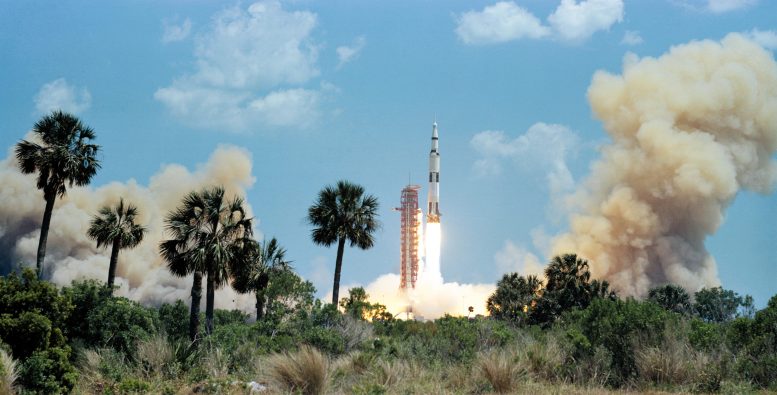The fifth Moon landing mission began with the April 16, 1972 launch of Apollo 16. The giant Saturn V rocket lifted off from Launch Pad 39A at NASA’s Kennedy Space Center (KSC) in Florida with Commander John W. Young, Command Module Pilot Thomas K. “Ken” Mattingly, and Lunar Module Pilot Charles M. Duke strapped inside their capsule.
After their rocket delivered them into a parking orbit around the Earth, the third stage reignited to send them on their way to the Moon. Following an uneventful three-day coast to the Moon, Young, Mattingly, and Duke arrived in lunar orbit on April 19 to prepare for the landing in and exploration of the Descartes site and to conduct scientific observations from lunar orbit.
The terminal countdown for Apollo 16’s launch began on April 14 and proceeded without any significant issues. Engineers in Firing Room 1 of KSC’s Launch Control Center (LCC) monitored all aspects of the countdown, including the final fueling of the Saturn V rocket. Young, Mattingly, and Duke ate their traditional steak and eggs breakfast before putting on their spacesuits and taking the Astrovan to Launch Pad 39A, where they boarded their spacecraft, the Command Module (CM) Casper
Young took the left-hand seat, Duke the right, and finally Mattingly settled in the middle. Thousands of spectators assembled along the beaches near KSC to view the launch. Vice President Spiro T. Agnew arrived in the firing room’s viewing gallery to watch the launch with senior NASA managers.
The countdown continued smoothly, with perfect weather for the launch. Liftoff on 7.7 million pounds of thrust came at 12:54 p.m. Eastern on April 16, 1972. The Saturn V rocket launched Apollo 16 into a clear afternoon sky. Ten seconds after the first motion, the rocket cleared the launch tower and mission responsibility shifted from KSC’s Firing Room 1 to the Mission Control Center (MCC) at the Manned Spacecraft Center, now NASA’s Johnson Space Center in Houston.
In the MCC, Flight Director Eugene F. Kranz led his White Team of controllers who monitored this phase of the mission, with NASA astronaut C. Gordon Fullerton acting as capsule communicator (capcom), the person who talked directly to the crew during the flight. After burning for 2 minutes and 42 seconds and lifting the rocket to an altitude of 40 miles, the first stage engines shutoff and the stage jettisoned.
The second stage continued to power the ascent until 9 minutes 20 seconds, taking the spacecraft nearly to orbit, at which time it too was jettisoned, and the third stage took over. It burned for two and a half minutes to place Apollo 16 into a circular 105-mile-high parking orbit around the Earth. The astronauts were now weightless, and Young reported enthusiastically, “Boy, it’s just beautiful up here, looking out the window. It’s just really fantastic. And the thing worked like a gem.”
For the next two and a half hours, Apollo 16, still attached to the Saturn V’s third stage, orbited the Earth. Young, Mattingly, and Duke removed their helmets and gloves but for now kept their spacesuits on. Together with Mission Control, they determined that all onboard systems were working nominally, and that they could proceed with Trans-Lunar Injection (TLI), the second burn of the Saturn V’s third stage to send them out of Earth orbit and toward the Moon. The engine ignited and fired for 5 minutes and 51 seconds, increasing Apollo 16’s velocity to 24,229 miles per hour to begin the three-day coast to the Moon.
Twenty-five minutes after the shutdown of the third stage engine, Fullerton called up to the crew that they were “Go” for the transposition and docking maneuver. Six minutes later, and already more than 4,200 miles from Earth, Mattingly separated the Command and Service Module Casper from the spent stage that still held the Lunar Module (LM) Orion. He moved Casper about 60 feet away before turning it around and starting the rendezvous process.
Duke set up a camera in the window and Mission Control received the image of the LM as they slowly approached it, along with what Duke called “a zillion particles” traveling with them, most likely flakes of paint from the LM. Seventeen minutes later, Mattingly brought the two spacecraft together to achieve a soft docking. Latches then joined the two to complete a hard docking. By the conclusion of the docking maneuver, less than three and a half hours after liftoff, Apollo 16 had traveled more than 7,800 miles from Earth.
While the crew slept, in Mission Control Flight Director Kranz and his White Team of controllers resumed their positions at the consoles, with astronaut Anthony W. “Tony” England as the new capcom. After a quiet night, the crew woke up, now 113,000 miles from Earth. The first activity of the day involved activating the Fluid Electrophoresis Demonstration experiment to assess the feasibility of using electrophoresis in space to separate cells and large molecules. Later in the day, Frank’s Orange Team of controllers with Peterson as capcom resumed their consoles to help the astronauts conduct a midcourse correction (MCC-2) maneuver, a two-second burn of the 20,000-pound thrust Service Propulsion System (SPS) engine to lower the point of closest approach to the Moon from 135 miles to 82 miles, the correct altitude for the Lunar Orbit Insertion (LOI) burn. Young and Duke activated the LM Orion, spending about two hours activating and checking out its systems and transferring items such as film cassettes. Mattingly made a brief visit inside Orion to take a peek. Philip C. Shaffer, a flight director assigned to the Skylab program, began his first shift, as he and his Purple Team came on for the overnight shift, with Hartsfield once again as capcom. Young, Mattingly, and Duke went to sleep, now 162,000 miles from Earth.
- Πηγή: scitechdaily.com




